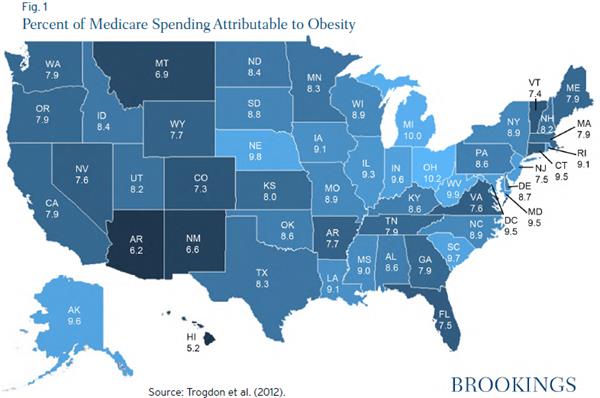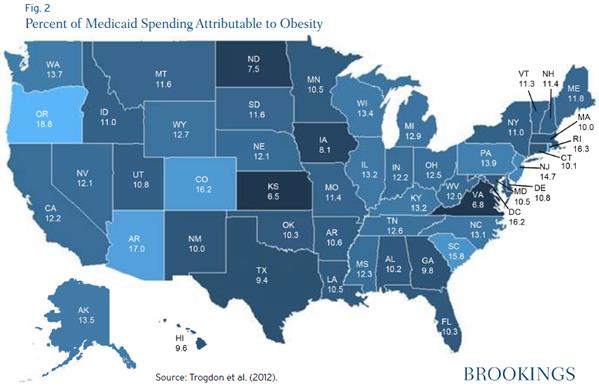Federal and state officials are growing alarmed over the mounting share of government-provided health care going toward treating obesity as the number of overweight Americans continues to rise.
In the past half century, the share of obese adults has increased from just one in eight in 1960 to over one in three today. More than a third of all adults and 17 percent of young people are obese, according to some experts. Many overweight people are plagued by related health problems, such as type 2 diabetes, coronary heart disease, stroke, hypertension, arthritis and cancer.
WHY THIS MATTERS
Federal and state officials can no longer take lightly the financial burden the obesity epidemic puts on Medicaid, Medicare and other government health care programs. If the new GOP-led Congress wants to find ways to reduce health care spending, a nationwide initiative to reduce obesity is a key way to go..
Related: Budget Busting U.S. Obesity Costs Climb Past $300 Billion a Year
The overall costs to the country is striking: An analysis prepared for The Fiscal Times earlier this year by Scott Kahan, director of the National Center for Weight & Wellness at George Washington University, put the annual cost of obesity at $305.1 billion. That includes direct medical and non-medical services, worker productivity losses, disability issues and premature death.
The financial implications for federal and state health care programs are particularly dramatic. Overweight children and adults have emerged in recent years as a distinctive, worrisome category in the Medicare and Medicaid programs because of the high costs of treating related health problems.
One study found that in 2006, the estimated additional Medicare spending for seniors due to obesity was more than $1,700 per beneficiary in inflation-adjusted dollars. At the same time, Medicaid spending for the poor due to obesity was measured at $1,021 per beneficiary, or triple the 1998 level, when adjusted for inflation.
A new analysis by Benjamin H. Harris and Aurite Werman of the Brookings Institution released last week highlights the levels of Medicare and Medicaid spending attributable to adult obesity. The large percentage of cases of obesity combined with the generally high costs to Medicaid and Medicare for treatment translates into $91.6 billion a year in federal expenditures on obesity.
Related: U.S. Obesity Rate Hits a Costly New High
“The high cost of obesity on medical spending has serious implications for federal and state budgets,” wrote the authors (Harris is policy director of The Hamilton Project at Brookings). “These high fiscal costs also suggest that initiatives to prevent and reduce obesity should be a public-sector priority, as lower obesity can not only improve Americans’ health but also substantially lower government spending on health programs.”
Harris and Werman correlated and crunched data generated by a research team headed by Justin Trogdon, an associate professor of health policy at the University of North Carolina, and from the 2006 Medical Panel Expenditure Survey. The study found that at the state level, a substantial share of Medicaid spending goes for treating overweight people – ranging from six percent to 20 percent of overall spending.
For example, in 2006 the highest shares of funding for low-income obese patients were found in Oregon with 18.8 percent, Arizona with 17 percent and Colorado with 16.2 percent. By contrast, the states that devoted the smallest share of Medicaid spending to obesity-related expenditures were Kansas at 6.5 percent, Virginia at 6.8 percent and North Dakota at 7.5 percent, according to the study.
“On a state-by-state basis, Medicare spending for seniors due to obesity was substantial, too, with shares varying from 5.2 percent to 10.2 percent in 2004,” according to the Brookings study. “The highest percent of obesity-attributable spending was found in Ohio (10.2 percent), Michigan (10 percent) and West Virginia (9.9 percent), while the lowest was in Hawaii (5.2 percent), Arizona (6.2 percent), and New Mexico (6.6 percent).”
Related: Has the U.S. Found a Cure for Rising Health Costs?
In terms of actual dollars spent, obesity-attributable Medicaid spending was the highest in California at $6.1 billion, New York at $5.9 billion and Texas at $2.7 billion, the study found, while Medicare spending to treat overweight people was highest in California ($4.2 billion), New York ($3.2 billion), and Florida ($3.1 billion).
Harris and Werman warn that rampant growth in the number of obesity-related medical cases has become an important driver of Medicare and Medicaid spending. Between 1974 and 2014, federal spending on major health programs rose from 1.0 percent of GDP to 4.8 percent. The Congressional Budget Office projects this spending will increase to 6.1 percent of GDP by 2024.
These two charts using 2012 data show state by state the percent of Medicaid and Medicare devoted to treating obesity:
Top Reads from The Fiscal Times:






